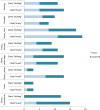From "Husky" to "Bulldog"- behavioural correlates between castration and breed groups in the domestic dog (Canis lupus familiaris)
- PMID: 38831350
- PMCID: PMC11145769
- DOI: 10.1186/s12917-024-04097-6
From "Husky" to "Bulldog"- behavioural correlates between castration and breed groups in the domestic dog (Canis lupus familiaris)
Abstract
Neutering dogs is a widespread method and is carried out for various behavioural and husbandry reasons. This study's main objective is to investigate the behavioural correlations between neutering and the breed of male dogs. In order to possibly find breed-dependent differences in the behaviour of intact and castrated dogs, a differentiation between two clades - the "Huskies"(chow chow, shar pei, akita/shiba inu, alaskan malamute, siberian/alaskan husky) and the "Bulldogs" (german boxer, english/french bulldog, old english mastiff, boston terrier, english bull terrier, staffordshire bull terrier, american staffordshire terrier), based on Parker et al. [1], was made.Using an online questionnaire,, 31 neutered and 37 intact male dogs from the clade "Huskies" and 30 neutered and 38 intact male dogs from the clade "Bulldogs", participated in the study (N = 136).The survey included detailed questions on the dogs' personality and any associated issues as well as a behavioural anamnesis. Further questions relating to four of the "big five" personality dimensions based on the "Budapest questionnaire" by Turcsán et al. from 2011 [2] were also added.The results show, that neutered males from both breed clades more frequently displayed aggression toward humans than intact males (multinomial logistic regression, p = 0.002). When it came to aggression towards other dogs, it was the "Huskies" that differed significantly from the "Bulldogs"(multinomial logistic regression, p = 0.04) with being more aggressive. There were also significant differences in stress-related behaviour depending on castration status and breed (multinomial logistic regression, p < 0.001; Cramer's V = 0.33) and only the castration status had an impact on the significance (multinomial logistic regression, p < 0.001). The analysis also revealed significance for stress-indicating behaviour with dependence on neutering status (multinomial logistic regression, p < 0.001) and showed that stress as well as uncertainty are significantly more common in neutered dogs depending on breed and neutering status (multinomial logistic regression, p < 0.001; Cramer's V = 0.42), in that only neutered "Bulldogs" were stressed, but more "Huskies" overall.According to the Budapest questionnaire data, the "Bulldog" clade had considerably greater extraversion scores overall (ordinal regression, p < 0.001) than the "Huskies".Our findings highlight the risks and potential negative effects of neutering. Gonadectomy in no way substitutes for the dog receiving the necessary socialization, training, or bonding. Although in some circumstances it might have a favourable impact on the dog's behaviour, it should not be seen as a panacea for unwanted behaviour. Given that not all behaviours are influenced by sex hormones, every castration decision must be weighed up individually.
Keywords: Behaviour; Breed; Bulldog; Castration; Husky; Neutering.
© 2024. The Author(s).
Conflict of interest statement
The authors declare no competing interests.
Figures




Similar articles
-
Personality Unleashed: Surveying Correlation of Neuter Status and Social Behaviour in Mixed-Breed Male Dogs across Weight Classes.Animals (Basel). 2024 Aug 22;14(16):2445. doi: 10.3390/ani14162445. Animals (Basel). 2024. PMID: 39199978 Free PMC article.
-
Self-reports of Dutch dog owners on received professional advice, their opinions on castration and behavioural reasons for castrating male dogs.PLoS One. 2020 Jun 22;15(6):e0234917. doi: 10.1371/journal.pone.0234917. eCollection 2020. PLoS One. 2020. PMID: 32569273 Free PMC article.
-
Assisting decision-making on age of neutering for German Short/Wirehaired Pointer, Mastiff, Newfoundland, Rhodesian Ridgeback, Siberian Husky: associated joint disorders, cancers, and urinary incontinence.Front Vet Sci. 2024 Apr 12;11:1322276. doi: 10.3389/fvets.2024.1322276. eCollection 2024. Front Vet Sci. 2024. PMID: 38681849 Free PMC article.
-
Decision-Making on Recommended Age of Spay/Neuter for a Specific Dog: General Principles and Cultural Complexities.Vet Clin North Am Small Anim Pract. 2023 Sep;53(5):1209-1221. doi: 10.1016/j.cvsm.2023.05.005. Epub 2023 Jun 15. Vet Clin North Am Small Anim Pract. 2023. PMID: 37330274 Review.
-
Early-age neutering of dogs and cats in the United States (a review).J Reprod Fertil Suppl. 2001;57:223-32. J Reprod Fertil Suppl. 2001. PMID: 11787153 Review.
Cited by
-
Variations in Canine Behavioural Characteristics across Conventional Breed Clusters and Most Common Breed-Based Public Stereotypes.Animals (Basel). 2024 Sep 17;14(18):2695. doi: 10.3390/ani14182695. Animals (Basel). 2024. PMID: 39335284 Free PMC article.
-
Dog Neuter, Yes or No? A Summary of the Motivations, Benefits, and Harms, with Special Emphasis on the Behavioral Aspect.Animals (Basel). 2025 Apr 6;15(7):1063. doi: 10.3390/ani15071063. Animals (Basel). 2025. PMID: 40218456 Free PMC article. Review.
-
Personality Unleashed: Surveying Correlation of Neuter Status and Social Behaviour in Mixed-Breed Male Dogs across Weight Classes.Animals (Basel). 2024 Aug 22;14(16):2445. doi: 10.3390/ani14162445. Animals (Basel). 2024. PMID: 39199978 Free PMC article.
References
-
- Turcsán B, Kubinyi E, Miklósi Á. Trainability and boldness traits differ between dog breed clusters based on conventional breed categories and genetic relatedness. Appl Anim Behav Sci. 2011;132:61–70. doi: 10.1016/j.applanim.2011.03.006. - DOI
-
- Warnes C. An update on the risks and benefits of neutering in dogs. Veterinary Nurse. 2018;9:150–5. doi: 10.12968/vetn.2018.9.3.150. - DOI
MeSH terms
LinkOut - more resources
Full Text Sources

